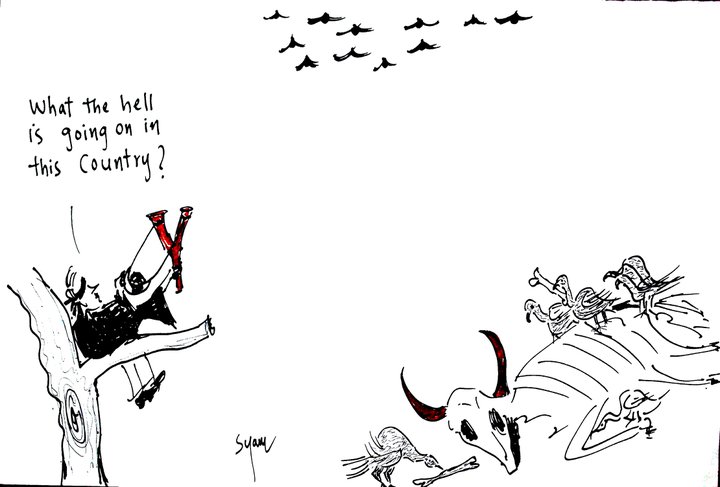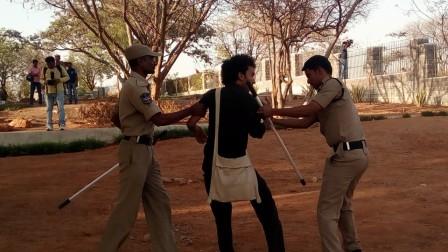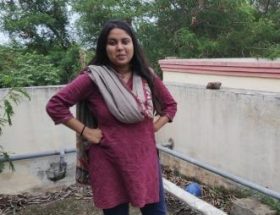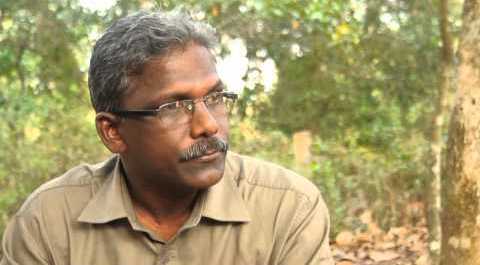Cynthia Stephen
The Gau-Vansh Vadh Pratishedh (Sanshodhan) Vidheyak (Prohibition of slaughter of cow-progeny Bill) just passed in Madhya Pradesh empowers the government to prosecute any person found slaughtering a cow or even transporting the calf for the purpose of slaughter. Anyone found guilty of this act would face seven years of imprisonment and a minimum fine of Rs 5000.
 In March 2010, the Karnataka assembly passed the The Karnataka Prevention of Cow Slaughter and Preservation of Cattle Bill 2010 by voice vote after uproarious scenes, and a four-hour acrimonious debate. All sections of the opposition were against the bill, which caused much consternation in Karnataka. One of the largest popular mobilizations in recent years was held in the Tasker Town grounds in March 2010 by a broad cross-section of progressives, minority groups and farmer’s groups to protest the bill just as it was being discussed. It was passed by both houses but has not become law as the Governor has sent it for Presidential assent. According to the Deccan Herald, the bill prohibits slaughter of cattle, sale, usage and possession of beef, puts restriction on transport of cattle and also prohibits sale, purchase or disposal of cattle for slaughter. The offence is punishable with imprisonment not less than one year which may extend up to seven years or a fine between Rs 25,000 to Rs 50,000 or both; second and subsequent offence would attract a fine of not less than Rs 50,000 up to Rs one lakh along with imprisonment penalty.
In March 2010, the Karnataka assembly passed the The Karnataka Prevention of Cow Slaughter and Preservation of Cattle Bill 2010 by voice vote after uproarious scenes, and a four-hour acrimonious debate. All sections of the opposition were against the bill, which caused much consternation in Karnataka. One of the largest popular mobilizations in recent years was held in the Tasker Town grounds in March 2010 by a broad cross-section of progressives, minority groups and farmer’s groups to protest the bill just as it was being discussed. It was passed by both houses but has not become law as the Governor has sent it for Presidential assent. According to the Deccan Herald, the bill prohibits slaughter of cattle, sale, usage and possession of beef, puts restriction on transport of cattle and also prohibits sale, purchase or disposal of cattle for slaughter. The offence is punishable with imprisonment not less than one year which may extend up to seven years or a fine between Rs 25,000 to Rs 50,000 or both; second and subsequent offence would attract a fine of not less than Rs 50,000 up to Rs one lakh along with imprisonment penalty.
The bill was intended to replace the Karnataka Prevention of Cow Slaughter and Cattle Preservation Act, 1964, to prohibit the slaughter of cows and calves of she-buffaloes, bull, buffalo male or female. It is also aimed at preservation and improvement of the breeds of cattle and to endeavour to organise agriculture and animal husbandry in terms of Article 48 of the Constitution. The bill provides for stringent punishment for violation of the act, and also provides for powers to search and seize any premises including vessel or vehicle. V S Acharya, BJP leader, said the bill was “in tune with the sentiments of the majority community”, and with the election manifesto of the BJP, and judgements of High courts and the Supreme Court.
The BJP governments in Karnataka and Madhya Pradesh may have brought these laws with the intention of putting pressure on the lifestyle and livelihoods of the minorities. But are these bills acts of political bravado on the part of the BJP? According to the Economic Times, dt. 6th Jan 2012, beef is the most popularly consumed meat in India – 26 lakh tons annually. In comparison, only 6 lakh tons of mutton and 14 lakh tons of pork were consumed in India. The article quotes the US Food and Drug Administration, saying India is in fact the third largest exporter of beef in the world, exporting as much as 1.28 million tons of it!
In MP, in particular, there is a large population of tribals – 13 million – for whom beef constitutes a staple. In Karnataka as well, large sections of the state’s population will be affected directly once the bill passes into law, including farmers, milk producers, leather workers, most of whom are Dalits and Muslims, and of course the common man.
The Economic Times report quotes Dr Jilukara Srinivas, Postdoctoral fellow, University of Hyderabad :”The constitution of India gives us the right to eat any kind of food; BJP is taking away people’s right to food through this law. They are not only targeting Muslims with this bill, but also the large tribal population of the state (of MP).”
One of the main reasons for the Karnataka bill, claimed C T Ravi of the Karnataka BJP, is the likelihood of shortage of milk due to the “current rate of cow slaughter in the state”. This assertion is refuted strongly by Mustafa Beig, a researcher and political analyst, and Convener of the United Forum for Public Awareness: “There is a 2007 report of the cattle census in the Department of Animal Husbandry that has been kept unpublished because it will give the lie to this claim: the report says that between 2003 and 2007, the number of cattle in the state actually grew from 95 lakh to 1.49 crore”, he says. “No one sells milch cattle which are worth over 15,000/- to be slaughtered, so the claim is totally specious”.
It is a myth to think that this will only affect the minorities – mostly Muslims and Christians, as it is popularly and wrongly believed will be the most affected, as it is they who slaughter the cattle and use it as a means of livelihood and a source of low-cost protein. These Bills have grave implications for the majority of the people of both states. In actual fact, it is the livelihoods of large sections of the poorer sections : farmers; cattle traders, transporters, loaders, etc; milk producers, especially those who have taken loans to purchase milch cattle – who are mostly women in SGHs; the leather industry, the pharma industry, the meat producers and sellers who include a large section of the economically weaker section and most Dalits.
In the case of milk producers, their profitability will be adversely affected as they will be forced to care for male cross-bred calves which are considered surplus and sold, because they are not suitable to be used in agriculture. This will cause a rise in cost of milk to the consumer in the short term. As milk producers will be faced with caring for economically unproductive aged cows they will stop rearing cattle; in the medium term this will result in lowered milk production, thus adding to the higher cost of milk and milk products, directly affecting the general population. In fact, farmer’s groups have already raised a demand for government to grant a kind of subsidy for rearing aged and unproductive cattle. Add to this the fact that the price of milk has gone up by three rupees a litre in early January 2012, in Karnataka.
To get a further idea of what this implies, let us look at the economic implications of the proposed blanket ban on cattle slaughter, in the state of Karnataka:
It is estimated that every day, all over the state, about 20,000 are culled : that is, economically unproductive cattle – are slaughtered in about 10,000 shops, resulting in the production of about 2 lakh kgs of meat, worth about 2 crore. Other byproducts, including the Hides, Bones, Horns, hooves, sinews etc are also generated about 1 crore. These byproducts are also the raw materials for the leather, pharma, and sugar industry which will be directly affected. The common man will feel the impact as a rise in the cost of products like iron and calcium supplements, shoes, handbags, and sugar.
It is estimated that the production of meat from cattle directly and indirectly employs about 12 lakh persons, mostly from the poor and marginalised sections : landless and marginal rural individuals who buy, sell and transport cattle, producers and vendors of meat and byproducts, etc.
As farmers and cattle rearers will no longer be able to sell their culled cattle they will be forced to look after them at thier own expense, with no hope of economic gain. This will discourage them from rearing cattle and will actually cause a decline in the cattle population.
Culling of animals is a scientific and economically prudent method of managing livestock which is adopted worldwide. The ecological impact of keeping lakhs of economically unproductive cattle alive, fed and watered, daily increasing by 20,000 in Karnataka alone, has to be considered. Imagine the huge state of Madhya Pradesh dealing with this situation.
“Where there is less and less arable soil and water, how and where does the state government plan to find the fodder and water to meet the needs of these unproductive cattle?” asks Mustafa Beig, adding that there is a present shortage of 150 lakh mt of grain for cattlefeed alone, not to speak of the huge demand-supply gap of both green and dry fodder for the existing, economically productive cattle.
Further, what is the government’s plan for the disposal of the carcasses after the cattle die a natural death? will they bury or cremate them? Who will pay for the cost of these? What about the air, water and soil pollution that will be caused as a result?
The government offers go rakshana shalas run by charitable trusts attached to religious mutts as an alternative means of “pensioning off” these cattle. But critics say that is a creative means of transferring public lands and public resources to these religious institutions, with total lack of transparency. On the contrary, says Sardar Ahmed Quraishi, President of the Tippu Sultan United Front, it is a way to impoverish and criminalise the 12 lakh population of the poor and marginalised, mostly minority and Dalit population whose livelihoods are based on the economy around the slaughter of economically unproductive cattle. “After all, when the animal is old, no body is going to look after it. We are giving it “mukti”, he says.
James, a young Dalit Activist, is more graphic. “You (upper castes) take the best of the cow – its labour, its milk, its offspring, and sell it after you have no use for it. When we find ways to use this resource, you attack us and even kill us (referring to the killing of 5 Dalits in Jhajjar, Haryana, in 2008, who were skinning the carcass of a cow after purchasing it). You are taking our livelihoods from us, even though we make it out of the waste you discard. Is this justice?”
“This law will take away food from the poor who cannot afford to buy chicken or mutton”, says another Dalit activist. “The cost of mutton, already high, will go up to one thousand rupees”, said Siddaramaiah, leader of the Opposition, during the Assembly debate. “Thus you will be thrusting vegetarianism on the people. This is only possible in Hitler’s regime. Is yours a Hitler’s regime?”
Thus it behoves the BJP governments in Karnataka and MP to pause and rethink before they bring such ill-advised laws into force. The state government’s real agenda of using the law to ride rough-shod over the rights of the minorities is hardly hidden. But it may become a case of cutting off one’s nose to spite one’s face, as the bill will open a Pandora’s box. The majority of the states’ populations will be directly affected, causing a daily loss of about minimum of Rs.4 crores to a large section of the poor and marginalised population in Karnataka alone who are bound to become restive at the loss of thier livelihoods. This will have a long-term effect on the social and political climate in the state, and adverse effects on the politics in the states and even the nation. Laws on cattle products are a red rag in this country: remember what led to the 1857 uprising in the Indian army. Will these laws contribute to a new uprising of the poor in India?
~~~
Cynthia Stephen is an independent writer and researcher.
Cartoon by Unnamati Syama Sundar.










